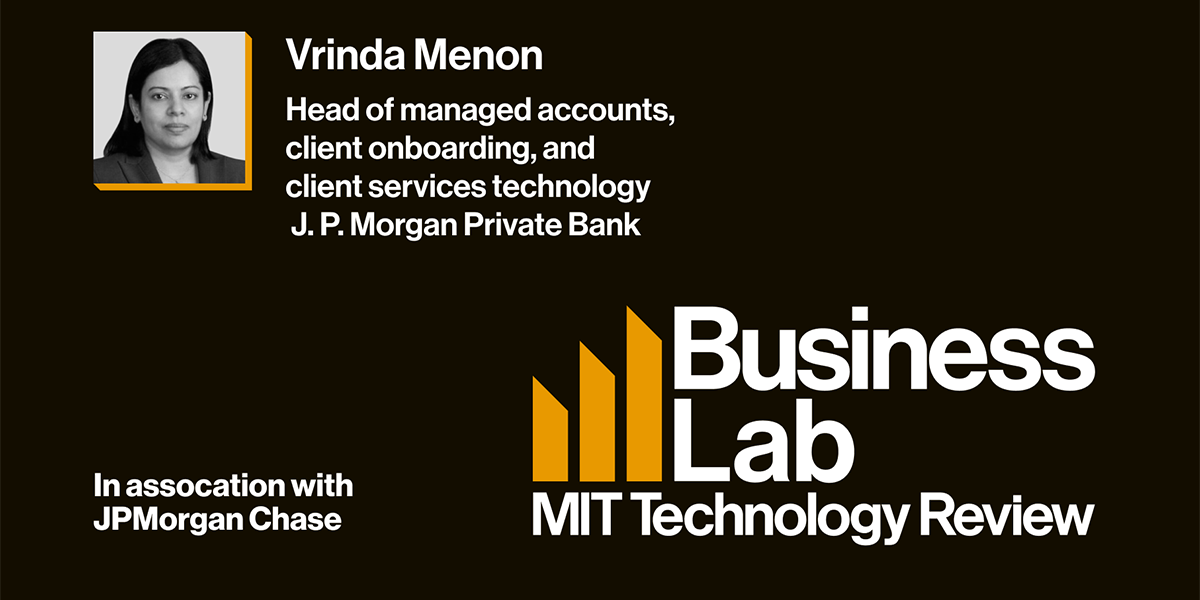Metaverse: Open for business?
Ever since Facebook’s rebrand to Meta, the metaverse—loosely defined as an extensive online world where interactions happen via digital avatars—has gone mainstream as part of “web3,” the internet’s third act in which users move from consumers to creators to residents in online worlds.
The entertainment and gaming industries are at the forefront of today’s metaverse buzz, but all enterprises are realizing the need to move early and not cede competitive ground. “Every company needs to find a place in the metaverse,” says Julie Smithson, cofounder of MetaVRse, which helps businesses build extended reality capabilities. “If companies are not ready for that, then they seriously need to consider their future. Whether it’s services or training applications, everything’s moving this way.”
Already the metaverse is increasingly part of companies’ merger and acquisitions (M&A) strategies. In December 2021, Nike announced its acquisition of digital design studio RTFKT, which the sportswear company says it hopes will help it explore the possibilities presented by the metaverse. In January 2022, Microsoft announced its plans to acquire game developer and interactive entertainment content publisher Activision Blizzard, which the software giant says it hopes will “provide building blocks for the metaverse.”
As an experiential medium, the metaverse has been most prominent at the consumer-facing level. Luxury fashion house Gucci, for example, has started selling items on gaming platforms with a digital version of a famous bag costing more than the physical model. Stella Artois, building on a history of live horse racing, has worked with Zed Run to create a 3D Tamagotchi-like experience crossed with the Kentucky Derby.
Virtual reality (VR) and augmented reality (AR,) precursors to the metaverse, were also initially oriented to consumers through gadgets like Google Glass or Oculus. But these never quite took off. It was in enterprise settings, such as manufacturing and healthcare training, that extended reality gained real traction by allowing workers to do fundamentally new things and amplify productivity, collaboration, and efficiency. Those same dynamics are carrying through into the metaverse era.
In January 2022, Hyundai, in partnership with Unity, a 3D content producer, announced plans to build a platform for a meta-factory to enable remote problem-solving, test runs of new facilities, and simulations for consumers. BMW has worked with AI company Nvidia to create a demo digital twin of a BMW production plant that allows 3D design teams to work together simultaneously across multiple software suites in a shared virtual space.
The market for digital twins—virtual representations that serve as real-time replicas of a physical object—is projected to grow to $86 billion by 2025, according to business consulting firm Grand View Research, with the likes of Unilever, Boeing, and Siemens Energy among the adopters.
A “health metaverse” is also taking shape. 8chili—a deep tech company that is building the underlying infrastructure for metaverse content creation and distribution—launched a partnership with digital therapeutics company Aventyn in March 2022 to develop a virtual reality platform to enable virtual training, patient engagement, and health coaching. In the UK, remote and augmented reality training company Virti has been working with the NHS to train and upskill staff, including during the pandemic, when many healthcare workers had to shift to different units and functions.
The financial services industry, already a heavy user of blockchain, is stepping up its interest in payments and advisory services in the metaverse. JP Morgan became the first major bank to enter the metaverse when it opened a “lounge” in the blockchain-based virtual world Decentraland at an event in February 2022. The Wall Street bank said it believed the metaverse could offer an eye-watering $1 trillion annual revenue opportunity for enterprises across all sectors. JP Morgan’s CEO Jamie Dimon believes a virtual real estate market could emerge with attendant services like credit, mortgages, and rental agreements.
For all sectors, the metaverse offers companies new opportunities for managing meetings, video conferencing, training, and broader workforce development in the post-covid hybrid world. In terms of future potential, global digital services provider Infosys believes the content creation and delivery space will see “immense innovation and competition” for the metaverse, citing digital twins of theaters, studios, and meetings rooms, which will enable “near-to-reality experiences” for users. Microsoft co-founder Bill Gates reckons virtual meetings will move to the metaverse in the next two or three years—Meta and Microsoft are already running them internally.
Where to start?
No company wants to be left behind in the rush to stake out a claim in the metaverse, whether for consumer-facing functions or internal enterprise uses, or both. Ignoring the trend and the underlying capabilities that are making it possible—especially 5G connectivity and improvements in chip technology—could be fatal, warns Smithson. “If a company thinks ‘this isn’t for us,’ they are not going to survive. Every company needs to find a place in the metaverse.”
How should companies start? One priority is to decide how their brand should be represented in the metaverse if consumers and customers inhabit virtual worlds at scale. “Brands have not thought about what they look like in a spatial environment,” says Smithson. “They have always thought of themselves in a 2D world on paper and a commercial, or a magazine article. This is a struggle right now with marketers, to think about their brands in an immersive way,” she adds.
And beyond the way it looks, enterprises also need to consider what consumers will get from engaging in their metaverse. According to Smithson, the metaverse needs to be rewarding for consumers, not merely a form of passive entertainment, which forces companies to think about questions like value exchange, incentives, and benefits. “If I’m a user or consumer, what are you going to give me if I go [to your metaverse]? This is how immersive experiences work: you exchange something for a reward if you want them to come back. What are those transactions?” says Smithson.
Such transactions could include the exchange of decentralized finance (DeFi) or non-fungible tokens (NFTs)—unique digital assets such as images, pieces of music, a 3D object, or other creative work. The NFT market is already booming. In March 2021, the first NFT artwork was sold at a major auction house for a staggering $69 million. And in December 2021, a piece called “The Merge” became the most expensive NFT sold when nearly 30,000 collectors together paid $91.8 million.
Smithson says that many companies are still a long way off creating their own NFTs or tokens for their brand, but as the metaverse develops, companies will need to consider how they will handle digital assets in a metaverse world in accordance with regulations around compliance and money laundering, and how they will mitigate the risk of cybersecurity scams.
Cybercriminals are already reportedly carrying out phishing scams via links that look like legitimate metaverse platforms. And new cyber threats could emerge in extended reality. Such cyber-threats could look like a hacked avatar or deepfake of, for example, a CEO, which could be used to authorize the transfer of funds or disclose protected commercial information that could be exploited. Scams are already rife in the world of cryptocurrencies and non-fungible tokens (NFTs). The metaverse could be a Wild West affecting staff as much as consumers. Sophisticated approaches to identity authentication and verification will be needed, especially as multiple “metaverses” emerge with governance and verification gaps or silos between them.
Data privacy and governance are also crucial considerations, for customers and employees alike. Julie Smithson cites a European medical technology company’s challenges as it builds out training and education in the metaverse. Many companies already have learning management systems (LMS), a key data repository, but there are many questions around what data can be collected from and about employees, such as during metaverse-based training scores and modules, like measuring how long someone hovers over a particular item or how long it takes them to answer a question. “These analytics are coming into play and clients are struggling with how to proceed,” says Smithson. MetaVRse is applying for full SOC (system and organization control) certification—a confidentiality standards system—to support it in data collection governance in the metaverse era.
As organizations consider their place in the metaverse, they will need to ensure they have the requisite resources to handle the level of computing power, including cloud and edge computing, ultrafast and reliable connectivity, and the skilled workforce to create and manage it. Already, demand for skilled workers in the metaverse is on the rise, including competencies like 3D modeling and gaming, a central dynamic of the metaverse so far, as well as metaverse-based events and community management. Expect new job titles and functions to emerge, just as the 2010s brought the arrival of “social media managers” and their kind. Also, expect a battle for niche talent, akin to the finance industry’s crypto hiring spree. There could be new segments of the economy too, such as gig work in the metaverse. Will changes to labor laws in the real-world economy be translated in the virtual world too?
There’s no doubt that the metaverse is changing business. But companies will also need to tread carefully when considering business-wide use cases. While much is made of metaverse-based meetings, the shift to virtual conference calls has been far from universally welcomed. Zoom fatigue is real. Will the metaverse overcome the jarring, disconcerting effects of virtual meetings, including lack of body language and mismatches between speech and eye contact? Will people behave less socially when behind the protection of an avatar? Billions of years of evolution mean humans cannot fully tell what people are thinking and feeling without being physically co-located. The subtle psychosocial nuances of human communication are a long way from being replicated in the online world—they may never be.
Despite the challenges, a proactive and inquisitive approach can help enterprises across the economy harness the benefits of the metaverse. The best strategies will be those that are focused on delivering real-world benefits, measuring return on investment, mitigating and preparing for risks, and balancing the benefits of an immersive virtual world with the value of the analog.
Learn more about the Infosys Microsoft Cloud Business and the Infosys Microsoft Workplace Transformation Services.
This content was produced by Insights, the custom content arm of MIT Technology Review. It was not written by MIT Technology Review’s editorial staff.



